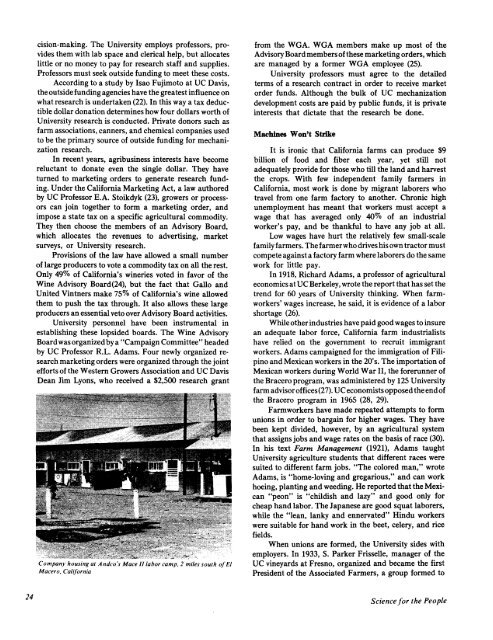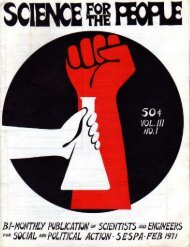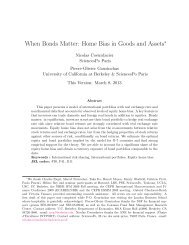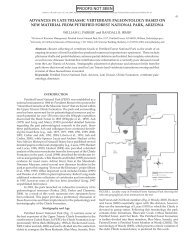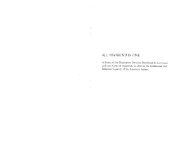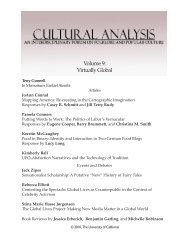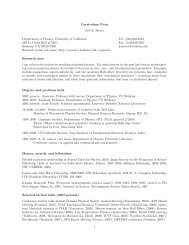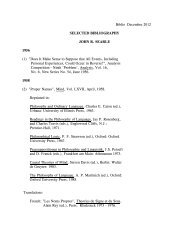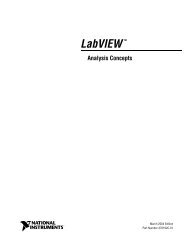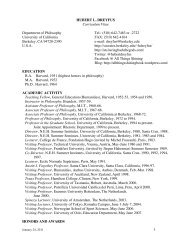Science for the People Magazine Vol. 10, No. 1
Science for the People Magazine Vol. 10, No. 1
Science for the People Magazine Vol. 10, No. 1
You also want an ePaper? Increase the reach of your titles
YUMPU automatically turns print PDFs into web optimized ePapers that Google loves.
24<br />
cision-making. The University employs professors, provides<br />
<strong>the</strong>m with lab space and clerical help, but allocates<br />
little or no money to pay <strong>for</strong> research staff and supplies.<br />
Professors must seek outside funding to meet <strong>the</strong>se costs.<br />
According to a study by Isao Fujimoto at UC Davis,<br />
<strong>the</strong>outsidefunding agencies have <strong>the</strong> greatest influence on<br />
what research is undertaken (22). In this way a tax deductible<br />
dollar donation determines how four dollars worth of<br />
University research is conducted. Private donors such as<br />
farm associations, canners, and chemical companies used<br />
to be <strong>the</strong> primary source of outside funding <strong>for</strong> mechanization<br />
research.<br />
In recent years, agribusiness interests have become<br />
reluctant to donate even <strong>the</strong> single dollar. They have<br />
turned to marketing orders to generate research funding.<br />
Under <strong>the</strong> Cali<strong>for</strong>nia Marketing Act, a law authored<br />
by UC Professor E.A. Stoikdyk (23), growers or processors<br />
can join toge<strong>the</strong>r to <strong>for</strong>m a marketing order, and<br />
impose a state tax on a specific agricultural commodity.<br />
They <strong>the</strong>n choose <strong>the</strong> members of an Advisory Board,<br />
which allocates <strong>the</strong> revenues to advertising, market<br />
surveys, or University research.<br />
Provisions of <strong>the</strong> law have allowed a small number<br />
of large producers to vote a commodity tax on all <strong>the</strong> rest.<br />
Only 49% of Cali<strong>for</strong>nia's wineries voted in favor of <strong>the</strong><br />
Wine Advisory Board(24), but <strong>the</strong> fact that Gallo and<br />
United Vintners make 75% of Cali<strong>for</strong>nia's wine allowed<br />
<strong>the</strong>m to push <strong>the</strong> tax through. It also allows <strong>the</strong>se large<br />
producers an essential veto over Advisory Board activities.<br />
University personnel have been instrumental in<br />
establishing <strong>the</strong>se lopsided boards. The Wine Advisory<br />
Board was organized by a "Campaign Committee" headed<br />
by UC Professor R.L. Adams. Four newly organized research<br />
marketing orders were organized through <strong>the</strong> joint<br />
ef<strong>for</strong>tsof<strong>the</strong> Western Growers Association and UC Davis<br />
Dean Jim Lyons, who received a $2,500 research grant<br />
Company housing at Andco's Mace //labor camp, 2 miles south of El<br />
Macero, Cali<strong>for</strong>nia<br />
from <strong>the</strong> WGA. WGA members make up most of <strong>the</strong><br />
Advisory Board members of<strong>the</strong>se marketing orders, which<br />
are managed by a <strong>for</strong>mer WGA employee (25).<br />
University professors must agree to <strong>the</strong> detailed<br />
terms of a research contract in order to receive market<br />
order funds. Although <strong>the</strong> bulk of UC mechanization<br />
development costs are paid by public funds, it is private<br />
interests that dictate that <strong>the</strong> research be done.<br />
Machines Won't Strike<br />
It is ironic that Cali<strong>for</strong>nia farms can produce $9<br />
billion of food and fiber each year, yet still not<br />
adequately provide <strong>for</strong> those who till <strong>the</strong> land and harvest<br />
<strong>the</strong> crops. With few independent family farmers in<br />
Cali<strong>for</strong>nia, most work is done by migrant laborers who<br />
travel from one farm factory to ano<strong>the</strong>r. Chronic high<br />
unemployment has meant that workers must accept a<br />
wage that has averaged only 40% of an industrial<br />
worker's pay, and be thankful to have any job at all.<br />
Low wages have hurt <strong>the</strong> relatively few small-scale<br />
family farmers. The farmer who drives his own tractor must<br />
compete against a factory farm where laborers do <strong>the</strong> same<br />
work <strong>for</strong> little pay.<br />
In 1918, Richard Adams, a professor of agricultural<br />
economics at UC Berkeley, wrote <strong>the</strong> report that has set <strong>the</strong><br />
trend <strong>for</strong> 60 years of University thinking. When farmworkers'<br />
wages increase, he said, it is evidence of a labor<br />
shortage (26).<br />
While o<strong>the</strong>r industries have paid good wages to insure<br />
an adequate labor <strong>for</strong>ce, Cali<strong>for</strong>nia farm industrialists<br />
have relied on <strong>the</strong> government to recruit immigrant<br />
workers. Adams campaigned <strong>for</strong> <strong>the</strong> immigration of Filipino<br />
and Mexican workers in <strong>the</strong> 20's. The importation of<br />
Mexican workers during World War II, <strong>the</strong> <strong>for</strong>erunner of<br />
<strong>the</strong> Bracero program, was administered by 125 University<br />
farm advisor offices (27). U C economists opposed <strong>the</strong> end of<br />
<strong>the</strong> Bracero program in 1965 (28, 29).<br />
Farmworkers have made repeated attempts to <strong>for</strong>m<br />
unions in order to bargain <strong>for</strong> higher wages. They have<br />
been kept divided, however, by an agricultural system<br />
that assigns jobs and wage rates on <strong>the</strong> basis of race (30).<br />
In his text Farm Management (1921), Adams taught<br />
University agriculture students that different races were<br />
suited to different farm jobs. "The colored man," wrote<br />
Adams, is "home-loving and gregarious," and can work<br />
hoeing, planting and weeding. He reported that <strong>the</strong> Mexican<br />
"peon" is "childish and lazy" and good only <strong>for</strong><br />
cheap hand labor. The Japanese are good squat laborers,<br />
while <strong>the</strong> "lean, lanky and ennervated" Hindu workers<br />
were suitable <strong>for</strong> hand work in <strong>the</strong> beet, celery, and rice<br />
fields.<br />
When unions are <strong>for</strong>med, <strong>the</strong> University sides with<br />
employers. In 1933, S. Parker Frisselle, manager of <strong>the</strong><br />
UC vineyards at Fresno, organized and became <strong>the</strong> first<br />
President of <strong>the</strong> Associated Farmers, a group <strong>for</strong>med to<br />
<strong>Science</strong> <strong>for</strong> <strong>the</strong> <strong>People</strong>


